In the eighteenth century, the area around the Place Saint Paul was known as “the old Jewry”. Until the first years of the twentieth century, the square itself bore the name Place des Juifs. The narrow streets here are best explored on a Sunday morning, when everyday Jewish life has resumed after the Shabbat.
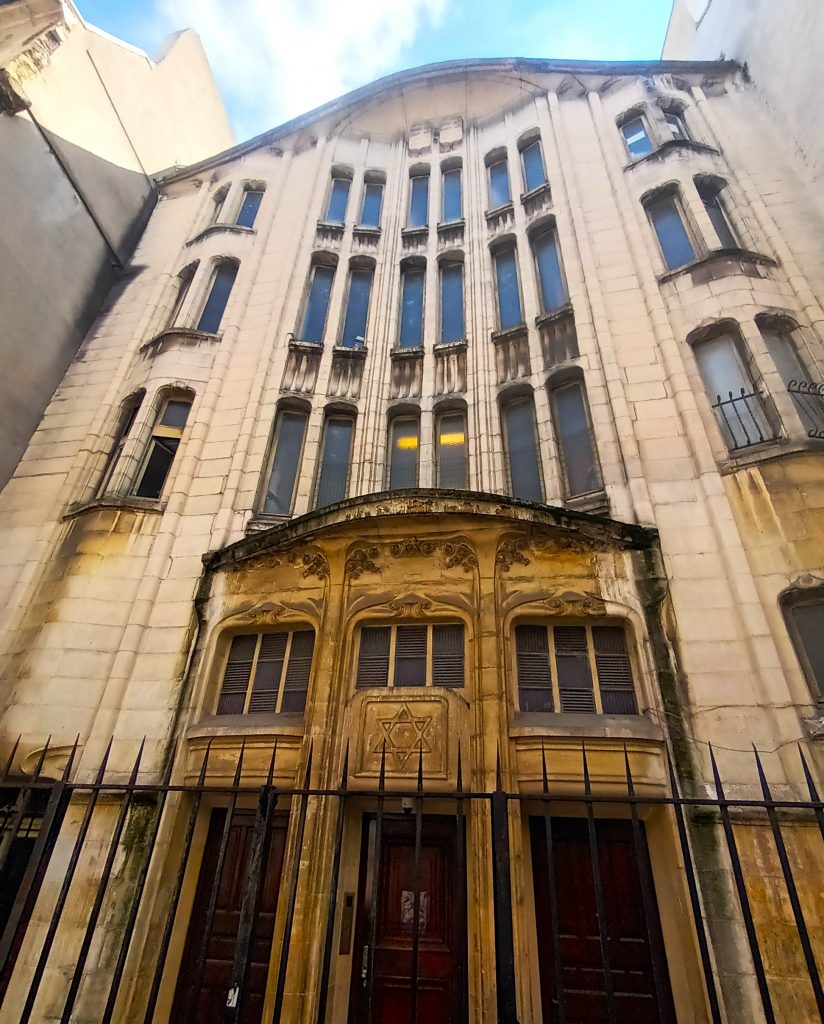
Rue Pavée is a few yards from the Saint Paul métro station. This is the pletzel, which is yiddish for small square. In this street, which runs perpendicular to rue des Rosiers, stands a surprising registered historical building in the “nouille” (noodle) style. This is the Pavée synagogue designed in 1913 by Hector Guimard, then the leading exponent of Art Nouveau, who is responsible for Paris famous métro entrances.
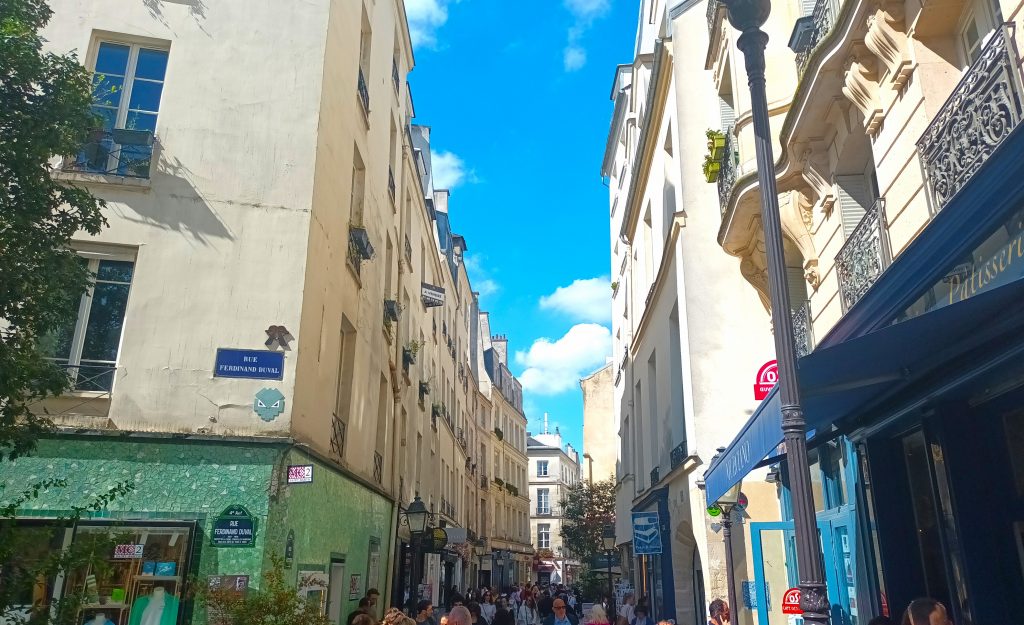
Jews have lived on rue des Rosiers since the middle ages. When Charles VI expelled them from his kingdom, the street fell empty -or so it seemed. That the newly emancipated Jews came back in this same street after the French Revolution, some 400 years later, had led historians to suggest that Jewish families went on living here in secret during the intervening centuries. Thus, when the edict was revoked, it was natural for many of the returning Jews to join fellow believers.
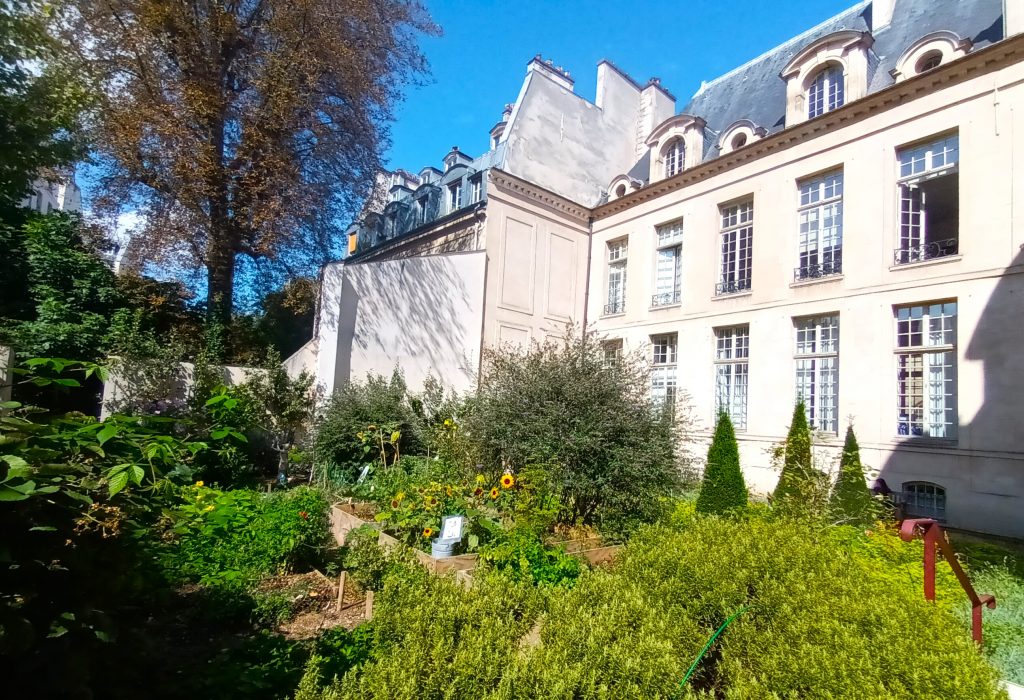
In all likelihood an oratory was built on the upper floor at 17 rue des Rosiers a few years before the French Revolution. Unfortunately, the relevant archives were destroyed during the Nazi occupation. Rue des Rosiers 10 leads to the Rosiers – Joseph Migneret garden , located between several buildings, named in honour of the teacher and headmaster of the Hospitalières Saint-Gervais primary schools (located in one of the buildings surrounding the garden) who saved Jewish children during the Holocaust.
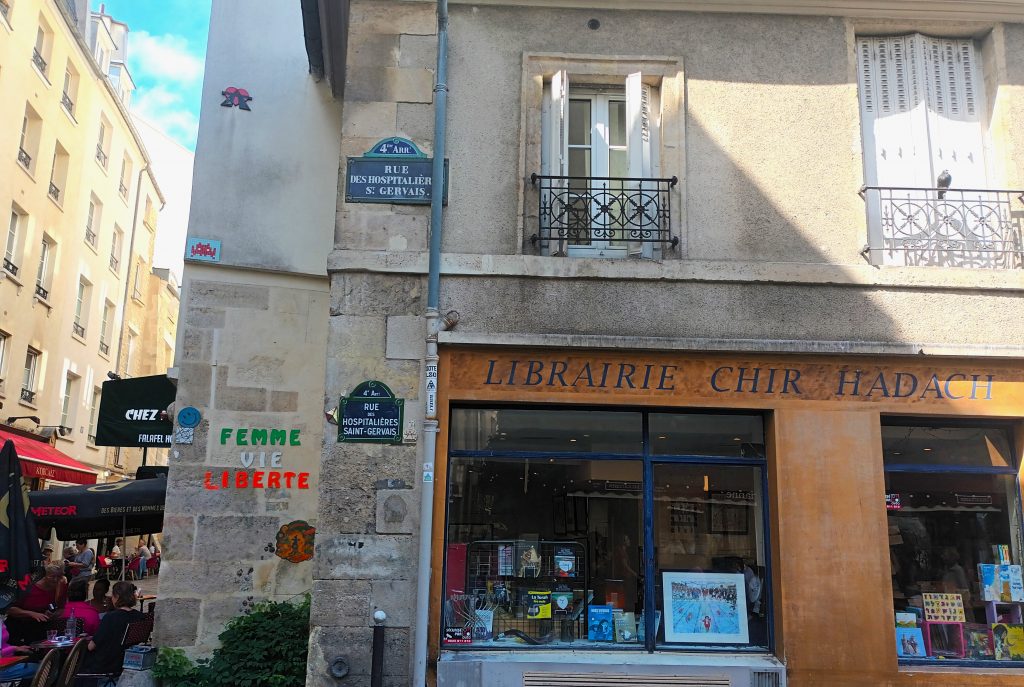
Today, in spite of its many luxury stores, rue des Rosiers remains an important center of Parisian Jewish life with its bookstores, especially the Temple Bookstore , the main reference with the mahJ’s library for books concerning Judaica.
Once a major center for Eastern European Jewish gastronomy, with the Goldenberg restaurant in particular, the Florence Kahn and Sacha Finkelsztajn delicatessens are still very popular, particularly for their Ashkenazi dishes, haloth and pastries. Since the early 2000s, other Jewish specialities have been delighting tourists. These include L’As du falafel and Schwartz’s with its New York-style pastrami sandwiches. For lovers of Israeli cuisine and its famous pita bread, don’t miss Miznon, designed by the famous chef Eyal Shani. The menu features spicy fish, ratatouille and homemade cauliflower in a warm, relaxed atmosphere. But also the Café des Psaumes, bringing together different generations of enthusiasts of the Pletzl atmosphere around conferences, concerts, workshops and courses. A plaque has been placed over the entrance to the former Goldenberg restaurant in tribute to the victims of the terrorist attack on 9 August 1982.
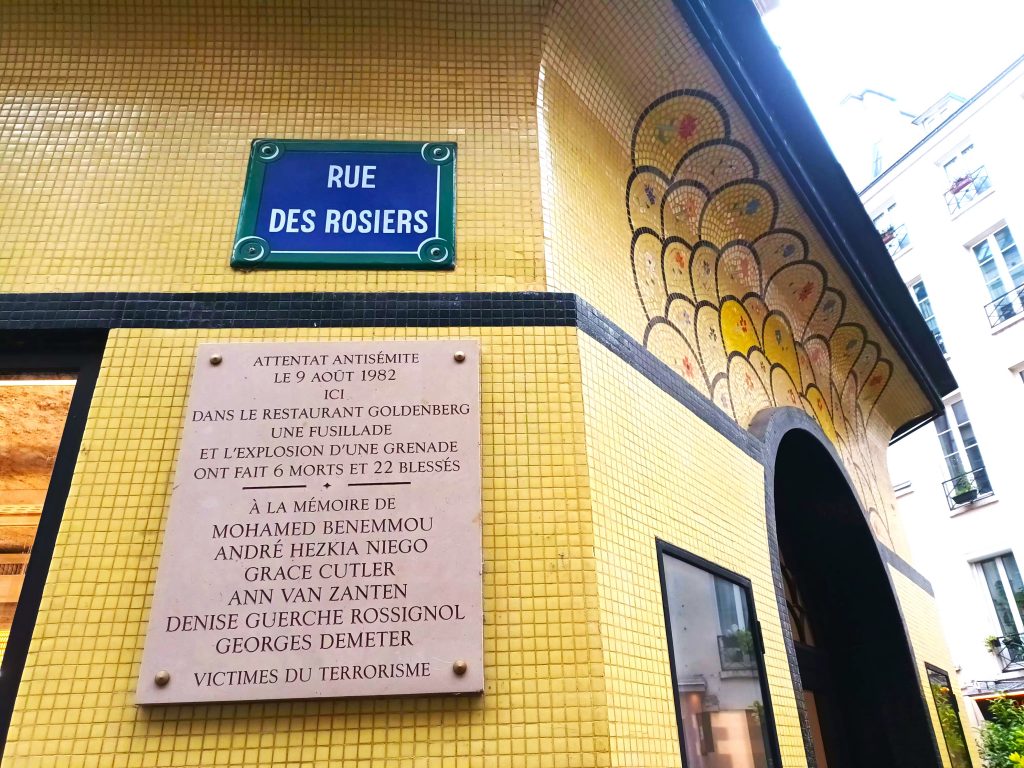
Many Jewish moneylenders lived on rue des Écouffes. In old French, escouffe was the word for a bird of prey, the kite, which was the symbol for pawnbrokers. The street name thus recalls the financial professions to which Jews were limited by the authorities. Until the beginning of the twentieth century, rue Ferdinand Duval was called “rue des Juifs” (Street of the Jews). Realizing that this moniker might be offensive, City Hall renamed it Ferdinand Duval, after a prefect of Paris.
On rue du Temple, you will find Galerie Saphir, founded in 1979 by Francine Szapiro, a journalist with a passion for art, and her husband, a doctor and founding member of the French Commission for Jewish Archives. At a time of Jewish cultural reconstruction, they shared the dream of opening a gallery that would showcase all aspects of this culture, its manifestations, ritual objects and ancient books… without confining it to a ghetto, motivated by the desire to show the reciprocal contribution of the surrounding cultures.
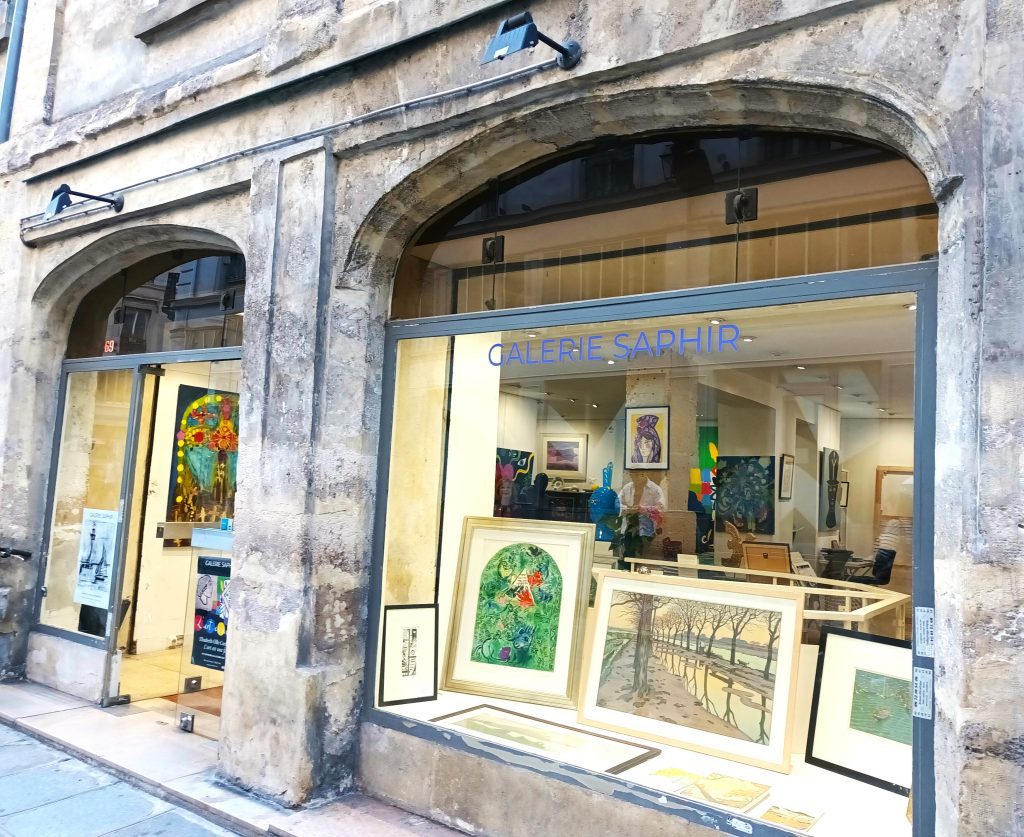
Their first gallery was on the boulevard Saint-Germain, and was opened by Elie Wiesel with an exhibition on postcards and Judaism designed to show the diversity of the Jewish world. They then began exhibiting Alain Kleinmann, then Shelomo Selinger. Then they moved to the current gallery.
Right next door to the gallery, on the same rue du Temple, is the unmissable mahJ, inaugurated in 1998.
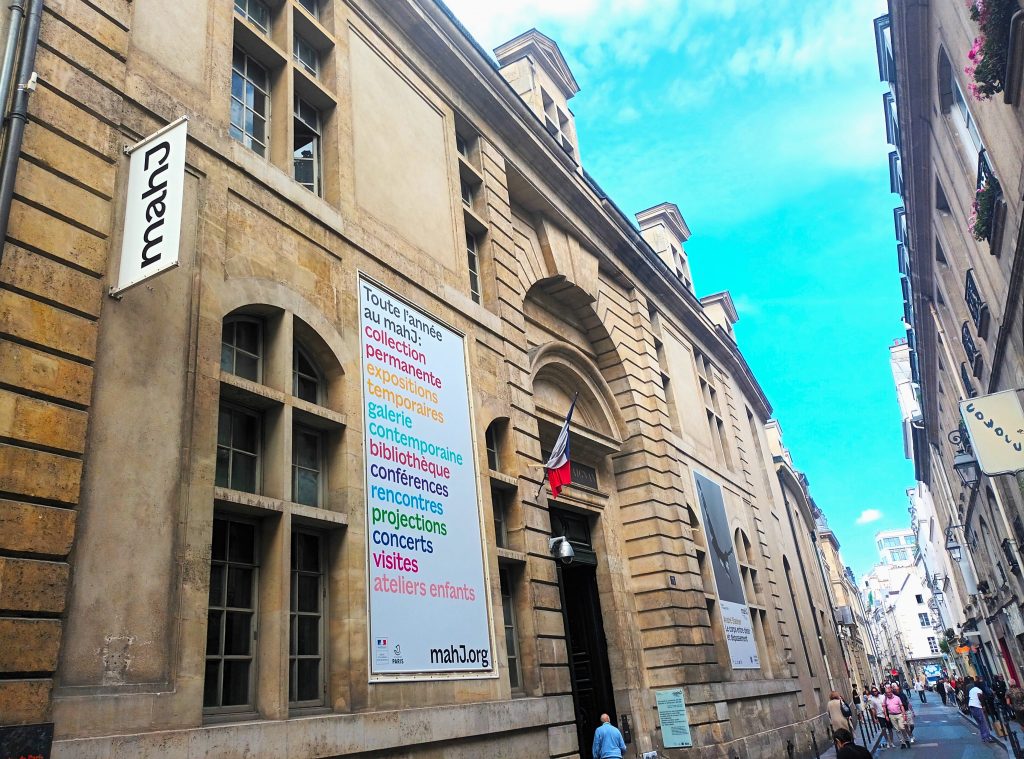
The Hôtel de Saint Aignan, a superb seventeenth century mansion, now houses the Museum of Jewish Art and History (Musée d’Art et d’Histoire du Judaïsme) remarkable both for its collections and for its ambition. The museum is the fruit of a three way cooperation between the City of Paris, the Culture Ministry and community institutions.
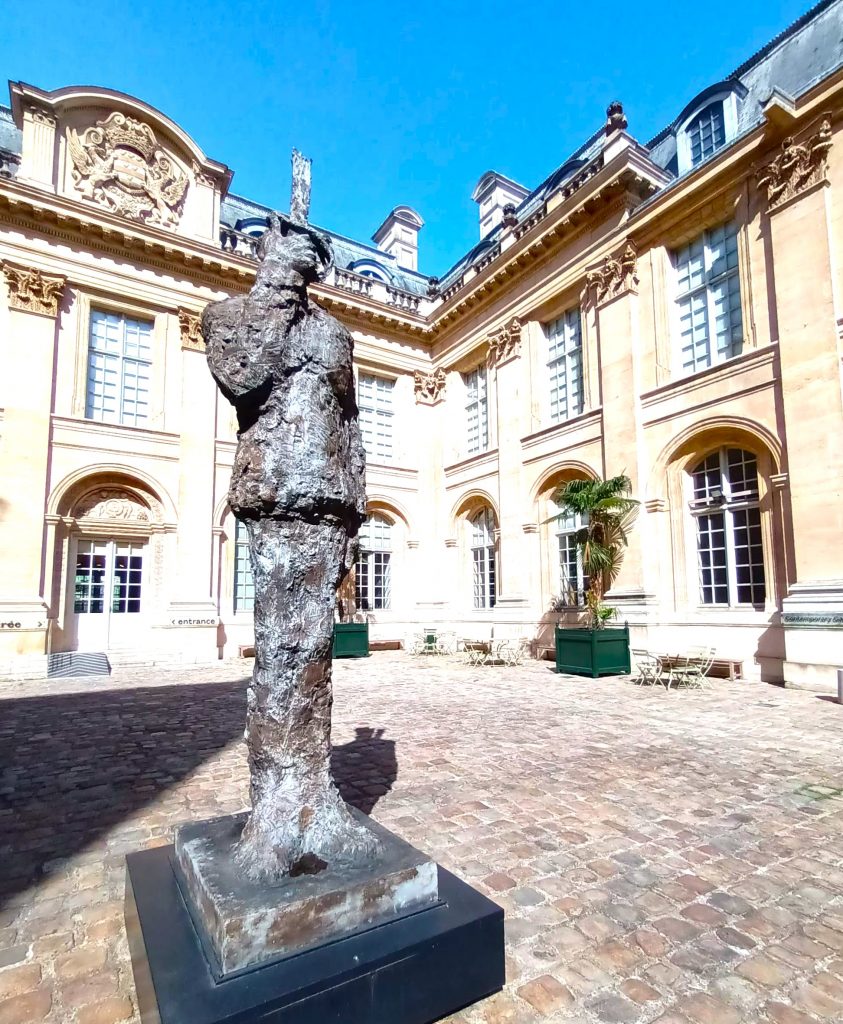
The museum is based on a collection assembled in the 19th century by the conductor Isaac Strauss. Like his Viennese namesakes, the French Strauss composed waltzes and got society dancing during the Second Empire. His success soon spread beyond France’s borders, and his passion for Jewish history led him to collect ritual objects from all periods during his travels around Europe. In 1890, this remarkable collection was acquired by Baroness Nathaniel de Rothschild, who donated it to the State. The museum also brings together objects that were long on display at the Museum of Jewish Art – now closed – opened after the war in Montmartre (wooden models of Polish synagogues made after the war by students at the ORT vocational school), the collections of the Consistoire of Paris (Torah crown, Galicia, 1810) and those of the Fondation du judaïsme français, as well as its own acquisitions (painting by Samuel Hirszenberg, The Jewish Cemetery, 1892).
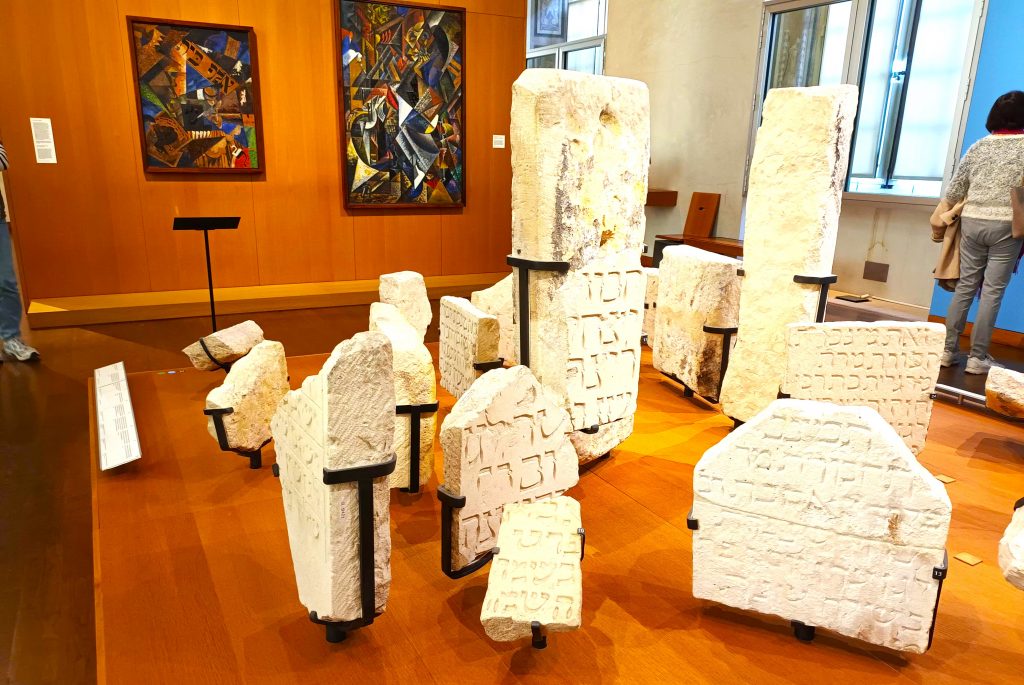
The visit starts on the first floor with the fundamental texts and symbolic objects. The rooms that follow reveal the diverse facets of Judaism. The medieval Jewries are represented by tombstones discovered in the nineteenth century when boulevard Saint Germain was built. Italy and its ghettos are represented by liturgical furniture (a circumcision chair [Kisei shel Eliyahu] from the early eighteenth century), silverware, and embroidery. Amsterdam, London and Bordeaux are evoked by objects and prints (a painting by Jean Lubin Vauzelle of the synagogue at Bordeaux, 1812) that exemplify integration of the Jews cast out of Spain. Considerable space is devoted as well to the celebrations that punctuate the Jewish year: Purim rolls, Hannukah lamps, a nineteenth century Austrian sukkah decorated with a view of Jerusalem.
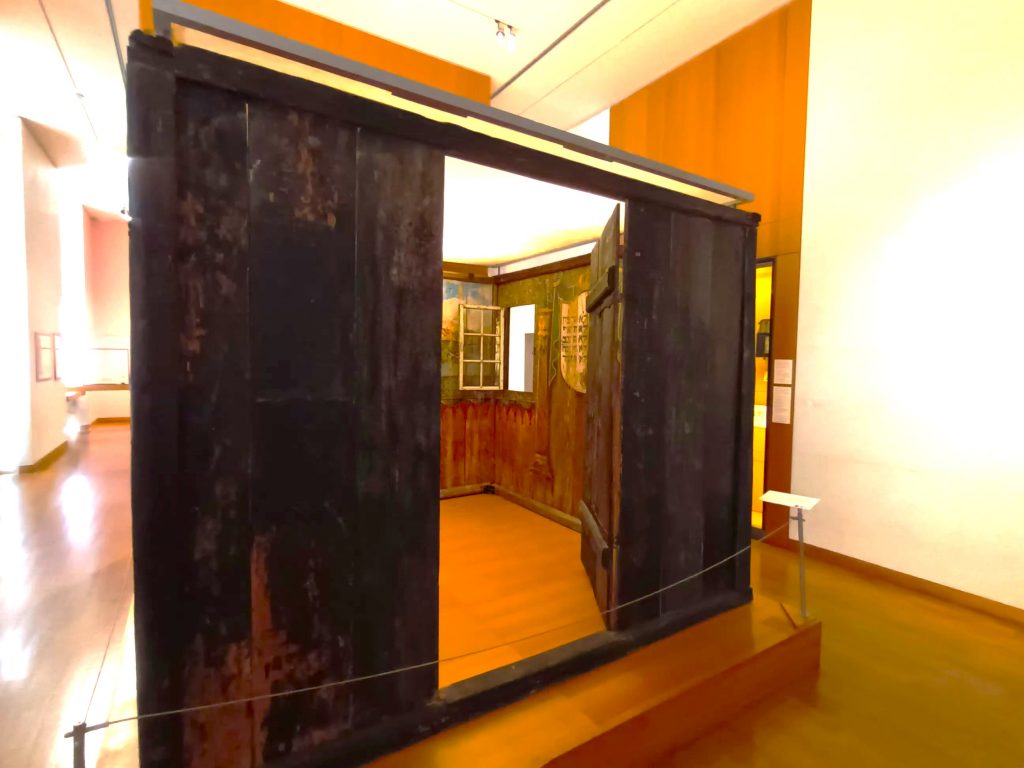
Two sections, the Traditional Ashkenazic World and the Traditional Sephardic World, offer overall artistic and religious views of these two main ritual communities. A sequence entitled “Emancipation: The French model” offers a historical vision from the French Revolution onward (an 1867 painting by Edouard Moyse shows the Great Sanhedrin of Paris), highlighting key moments of integration. The Jewish presence in twentieth century art presents works from the early decades of the last century. Underlying these runs the eternal question of Jewish expression in art through folklore, ornament, biblical sources and calligraphy.
The evocation of the Shoah is intended as a memorial, a pause in the itinerary. Finally, temporary exhibition rooms open to contemporary artists, an auditorium for concerts, lectures and screenings, a library, a photo library, a video library and a tea room complete this impressive ensemble.
Our interview with Paul Salmona, Director of the mahJ, who tells us about the history of the museum and its great moments, as well as the its future projects.
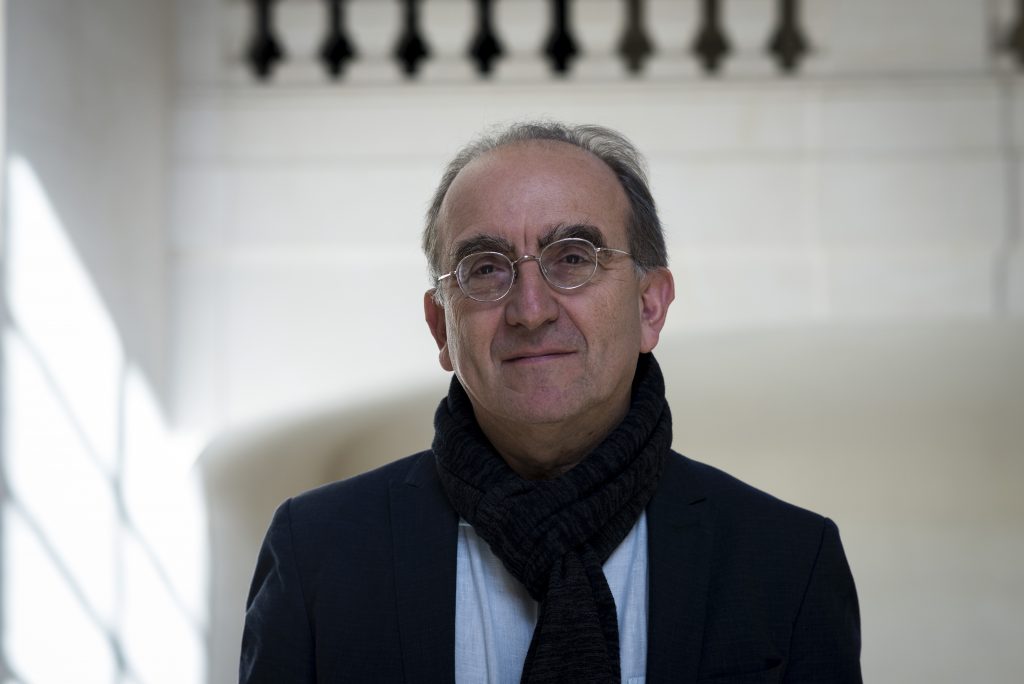
Jguideeurope: What is the origin of the choice of place to host the mahJ?
Paul Salmona: The idea of a museum of Judaism in Paris is quite old, but it crystallized in 1980 with the exhibition at the Grand Palais of masterpieces from the Jewish collection of the Musée de Cluny. The project then took shape with the search for a place. Claude-Gérard Marcus, an elected official from Paris, convinced Jacques Chirac to make the Saint-Aignan hotel available, acquired by the city in 1962 as part of the Marais safeguard plan. At the same time, Jack Lang undertook to co-finance the project and to deposit the Cluny collection there. A prefiguration association was created in 1988 and ten years later the museum opened under the aegis of Laurence Sigal, the first director. It made sense to install it in this aristocratic palace occupied from the 19th century by workshops of furriers, tailors, cap makers and hatters, halfway between the rue des Rosiers and the synagogue of Nazareth, in a neighborhood which welcomed waves of Jewish immigration from eastern France, then central and eastern Europe. A work by Christian Boltanski recalls this story in a work entitled “The Inhabitants of the Hôtel de Saint-Aignan from 1939” and installed in a courtyard.
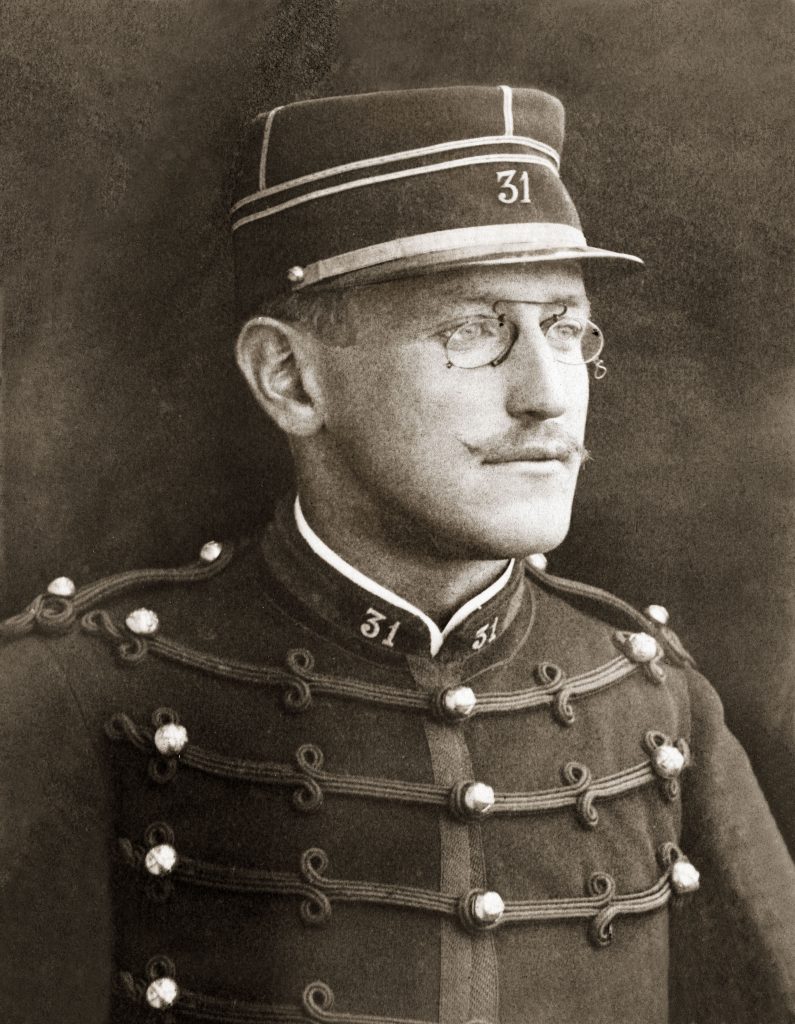
Can you tell us about some particularly striking moments in the mahJ?
There are so many in 22 years of intense activity. Among the acquisitions, mention should be made of the donation of the 2,600 archives of the Dreyfus affair by the captain’s family, or the purchase in 1988 of the Austrian soukkah, Laurence Sigal’s first acquisition against payment; we can mention the gift of the Columns of Guerry by Georges Jeanclos by the artist’s family, the purchase of 435 old photographs by Helmar Lerski thanks to a public subscription… Before taking up my post, I was very marked by the he exhibition “Future Futur” which revealed to the French public the avant-garde of the years 1914-1939 which aspired to create a truly Jewish modern art by drawing on the traditional folk art of Yiddishsland. Another example is the Golem Exhibit, which showed how this myth permeates the West even though few people know that it was originally a Jewish legend. The Charlotte Salomon exhibition was a real discovery for the public, which had as its posterity the reissue of Vie? Ou théaâre? by Le Tripode, a huge success for an art book of this ambition. I am also thinking of the self-portraits of Arnold Schönberg, which were little known and whose exhibition made a big impression on the public. The mahJ has also given a good place to the 9th art with “From Superman to the Rabbi’s Cat” and “The worlds of Gotlib” or “René Goscinny, beyond laughter”.
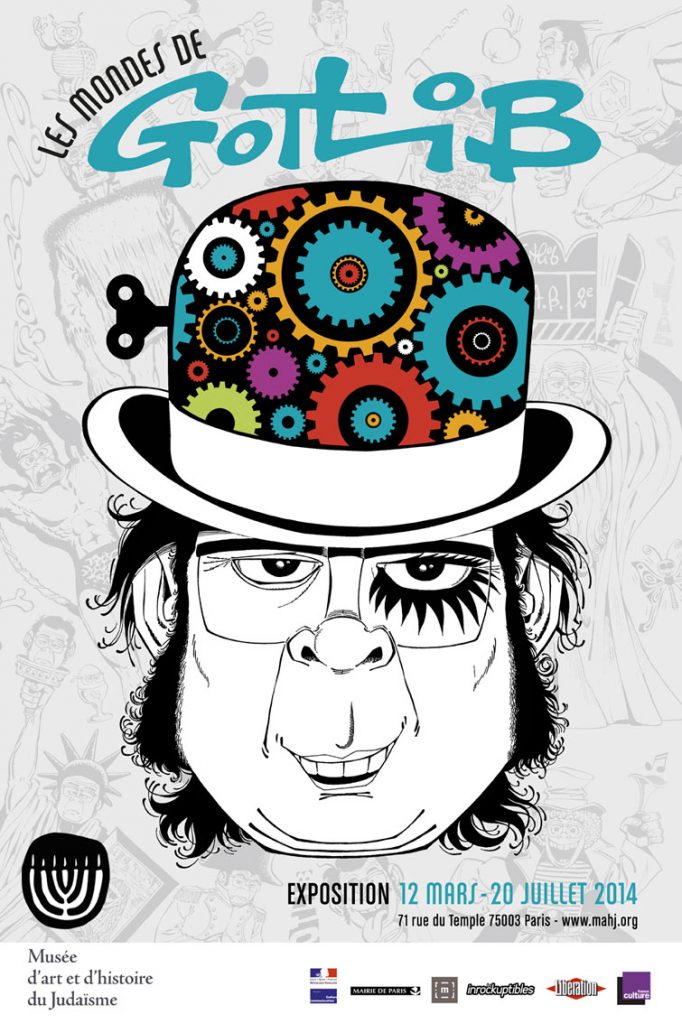
Can you think of another place related to Jewish cultural heritage that is important to you personally and that deserves to be better known?
I am thinking first of the synagogue of Cavaillon, built in the middle of the 18th century on the site of the medieval synagogue. Very rococo style, it is well highlighted by its recent restoration. It is the witness of a vanished world, that of the Comtadin Jews, which had survived the medieval expulsions but disappeared with the Emancipation and the departure of these rural elites to the big cities. I am also thinking of the medieval Jewish monument of Rouen, discovered by chance in the courtyard of the Palais de Justice in 1976. It is the oldest Jewish archaeological remains in elevation, dating from the end of the 11th – beginning of the 12th, whose architecture has the same qualities as those of contemporary Romanesque churches. After the discovery, it had been covered by a hideous slab of concrete, hampering its conservation and complicating its visit. It is a place that bears witness to the importance of the Jewish presence in France before the expulsions of the late 14th century. It is also located rue aux Juifs, a toponym that recalls the central place of Jews in cities in the Middle Ages in France. Recent archaeological research tends to show that this building was a synagogue. Benches were found on the first floor with a “header” stone at the bottom which probably supported the holy ark.
We were previously talking about these disappearing places of Jewish cultural heritage. Conversely, the mahJ has an expansion project. Can you tell us more?
The mahJ currently has a permanent course of 1000 m² dating from the 1990s, which is insufficient. We have an ambitious but realistic extension project under the Anne Frank Garden. It will make it possible to gain 1,000 m², and create rooms of 550 m² for temporary exhibitions. As for the current temporary exhibition rooms, they will allow the permanent exhibition to be extended to an additional 400 m². The route will start with the Jewish presence in France in Antiquity (essential for schoolchildren) and will continue with the height of Franco-Judaism in the interwar period, the rescue of the Jews during the Occupation, the reconstruction of Judaism in France after 1945 and the contemporary collection. It is an 18 M € project which benefits from the financial support of the city of Paris and the State for two thirds. We are therefore looking for € 6 million from private donors. We hope to open in 2025 in a completely renewed museum.
As you walk toward the Place des Vosges, you’ll find on this beautiful place the Charles Liché Synagogue , built in 1963 and named after its founder and rabbi.
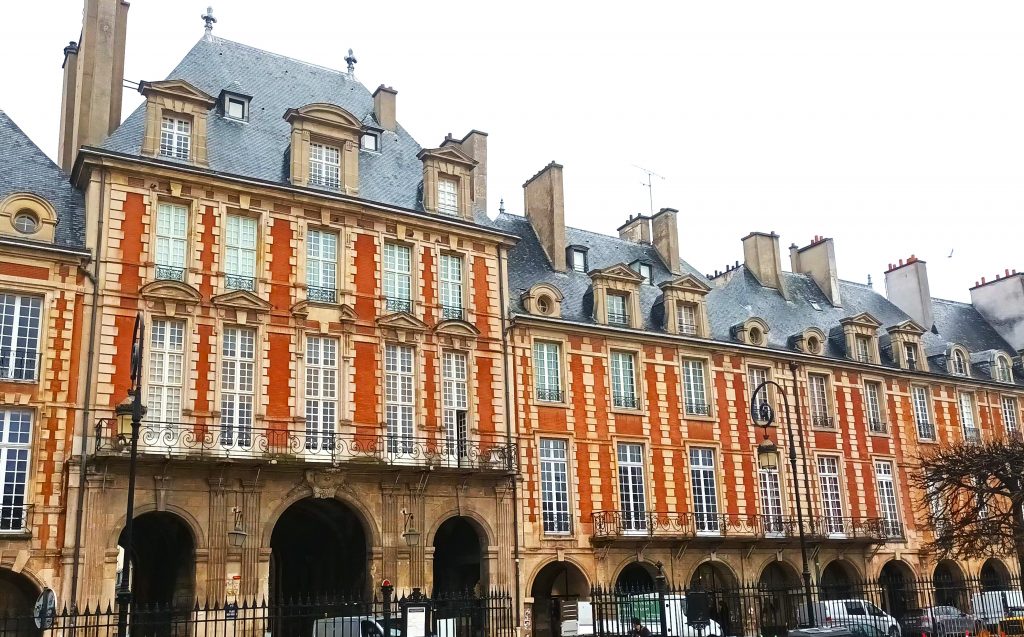
One street behind, there is the Synagogue on rue des Tournelles . The original building, from 1861, was burned down during the Paris Commune of 1871. It was rebuilt following a design by Marcellin Varcollier in a style close to that of the synagogue on rue de la Victoire.

The facade features the Tablets of the Law and the Paris city coats of arms. Consecrated in 1876, this synagogue has a visible metal inner structure built in the workshops of Gustave Eiffel more than ten years before his famous Tower. The two rows of galleries, made entirely of iron and cast iron, provide both support and ornament.